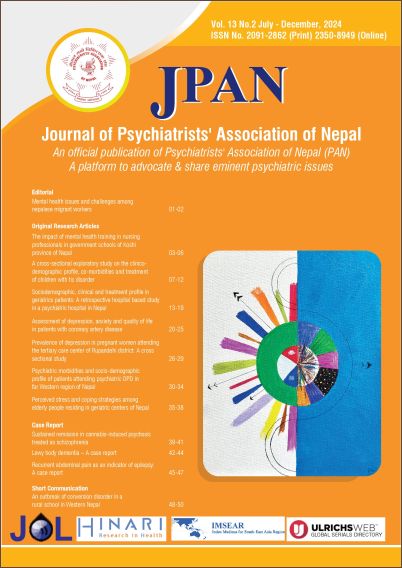A cross-sectional exploratory study on the clinico-demographic profile, co-morbidities and treatment of children with tic disorder
DOI:
https://doi.org/10.3126/jpan.v13i2.74916Keywords:
Children, Tic Disorder, Tourette's Disorder, Yale Global Tic Severity ScaleAbstract
Introduction: Tic disorders encompass a spectrum of involuntary, repetitive movements or sounds, varying in complexity and severity, affecting individuals across different age groups. Tourette's disorder specifically presents as a neurological condition characterized by multiple
motor and vocal tics lasting for more than a year, often accompanied by other behavioral or mental health conditions.
Methods: The study examines tic disorders in a group of 10 children under 14 at the child and adolescent mental health unit of Kanti Children’s Hospital. It utilized the Yale Global Tic Severity Scale- Revised (YGTSS-R) to comprehensively analyse this neuro-developmental disorder, exploring various tic manifestations, complexities, and their impact. Further Rutter’s multi-axial diagnoses was used for multidimensional assessment in understanding tic disorders comprehensively.
Results: The children in our study had both simple and complex motor tics, with a contrast between the types of motor and vocal tic symptoms. Using multi-axial diagnosis specific co-morbidities were also identified in our study cohort. Correlations between socio-demographic
factors and clinical profiles were inconclusive in this limited sample.
Conclusion: The detailed assessment provided insights into tic characteristics, advocating for tailored treatment modalities like pharmacological interventions, psychoeducation, habit reversal therapy, and cognitive behavioral interventions. The study emphasizes the necessity for comprehensive assessments and individualized interventions to address the varied manifestations and impacts of tic disorders in affected children.
Downloads
Downloads
Published
How to Cite
Issue
Section
License
Copyright (c) 2024 Journal of Psychiatrists' Association of Nepal

This work is licensed under a Creative Commons Attribution 4.0 International License.
This license enables reusers to distribute, remix, adapt, and build upon the material in any medium or format, so long as attribution is given to the creator. The license allows for commercial use.




